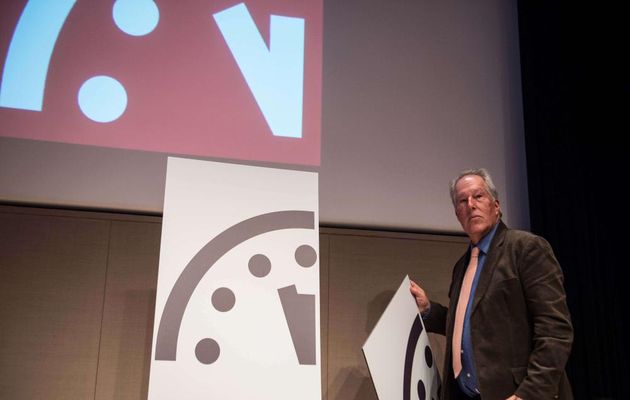In a purely symbolic but still unsettling move, the Bulletin of Atomic Scientists has moved the minute hand on its Doomsday Clock two minutes closer to midnight.
 Professor Richard Sommerville unveils the 'Doomsday clock'. / AP
Professor Richard Sommerville unveils the 'Doomsday clock'. / AP
In a purely symbolic but still unsettling move, the Bulletin of Atomic Scientists has moved the minute hand on its Doomsday Clock two minutes closer to midnight. On the 60-year-old Doomsday Clock, midnight is nuclear destruction, the 'end of life as we know it'.
Manhattan Project physicists, who developed the atomic bomb for the United States, instituted the clock in 1947 after their bombs wiped out Hiroshima and Nagasaki at the end of World War II. Since then, the Bulletin of Atomic Scientists (BAS), which boasts 18 Nobel Prize winners among its leaders, has moved the hand on the clock 18 times.
Each move symbolizes the group's current analysis of the world's chances of survival in the face of political, environmental and technological developments. The most notable factor to the keepers of the clock is the state of nuclear affairs -- whether the world is in a proliferation trend or a disarmament trend. The latest move puts us at 11:55 p.m. In an announcement on Wednesday, the BAS cited several reasons for its dark prediction regarding humankind's proximity to obliteration.
The BAS believes the world has entered a "second nuclear age," the first nuclear age having ended with the signing of the Strategic Arms Reduction Treaty in 1991 by the United States and Russia. Since then, the tide has slowly turned away from a global decision to limit nuclear-weapons technology and toward the creation of new nuclear states.
The United States and Russia currently have more than 26,000 nuclear weapons ready to launch at a moment's notice, and the United States recently established a policy that makes small nuclear bombs viable weapons against certain security threats. In the meantime, says the BAS, the world's nuclear watch dogs have done little but loudly protest, and as a result, the world faces the most dangerous nuclear climate since the Cold War.
In the last five years alone, Pakistan and India were locked in a nuclear standoff; North Korea has declared itself a new member of the club by detonating a nuclear bomb; Iran is widely believed to be on the path to a nuclear weapon; and the growing presence not only of nuclear arsenals but also nuclear-power-plant technology has made the sale and possession of nuclear materials nearly impossible to fully track and regulate. The idea that a small group could get its hands on enriched plutonium or uranium is far more realistic today than it has ever been.
Nuclear concerns have always comprised the bulk of factors moving the hand on the clock. But in 2007, actual climate for the first time rivaled nuclear climate for greatest threat. In moving the clock to 11:55, the BAS made a hard case for the destructive power of climate change.
The organization now considers global warming to be only slightly less threatening to the future of life on Earth than nuclear holocaust. Citing the melting of ice in Greenland, desertization of once-fertile areas, pollution of the air and oceans and other ecological nightmares, the BAS believes that climate change will ultimately lead to widespread nuclear wars over habitable land that will end up destroying whatever is left of the Earth.
The predictions are dire, to say the least. In addition to nuclear and climate concerns, the scientists of the BAS also point to emerging technologies in the area of bioscience and nanoscience as contributing to the symbolic "five minutes to the end." The ultimate uses of recent, giant advances in both genetics andnanotechnology have yet to be determined. Genetic engineering may cure cancer; it may also create a super-human weapon. Nanotechnology may build an elevator to space or perform more precise surgery than ever thought possible; it may also result in a bomb the size of a gnat.
But all is not lost. See The Bulletin of Atomic Scientists Web site to read about some of the BAS-recommended changes the world can make in order to move the Doomsday Clock back.
The closest the clock has ever been to midnight is 11:58 p.m., which was in 1953, the year both the United States and Russia tested hydrogen bombs. Hydrogen bombs are more powerful than the atomic bombs developed by the Manhattan Project physicists.

Las opiniones vertidas por nuestros colaboradores se realizan a nivel personal, pudiendo coincidir o no con la postura de la dirección de Protestante Digital.
Si quieres comentar o